Analysis of T plc's Business Performance Using Financial Ratios
VerifiedAdded on 2023/06/18
|6
|1230
|223
Report
AI Summary
This report provides a detailed evaluation of the business performance of T plc, a retailer, through the analysis of various financial ratios including profitability, liquidity, working capital management, and stock market performance. The analysis reveals that T plc outperforms industry standards in profitability and stock market performance, while its liquidity is slightly below average. Recommendations suggest that T plc is a worthwhile investment due to its strong profitability and returns to shareholders. The report concludes that continuous analysis of business performance is crucial for identifying areas of improvement and developing effective strategies. Desklib is a platform where students can find similar solved assignments and study resources.
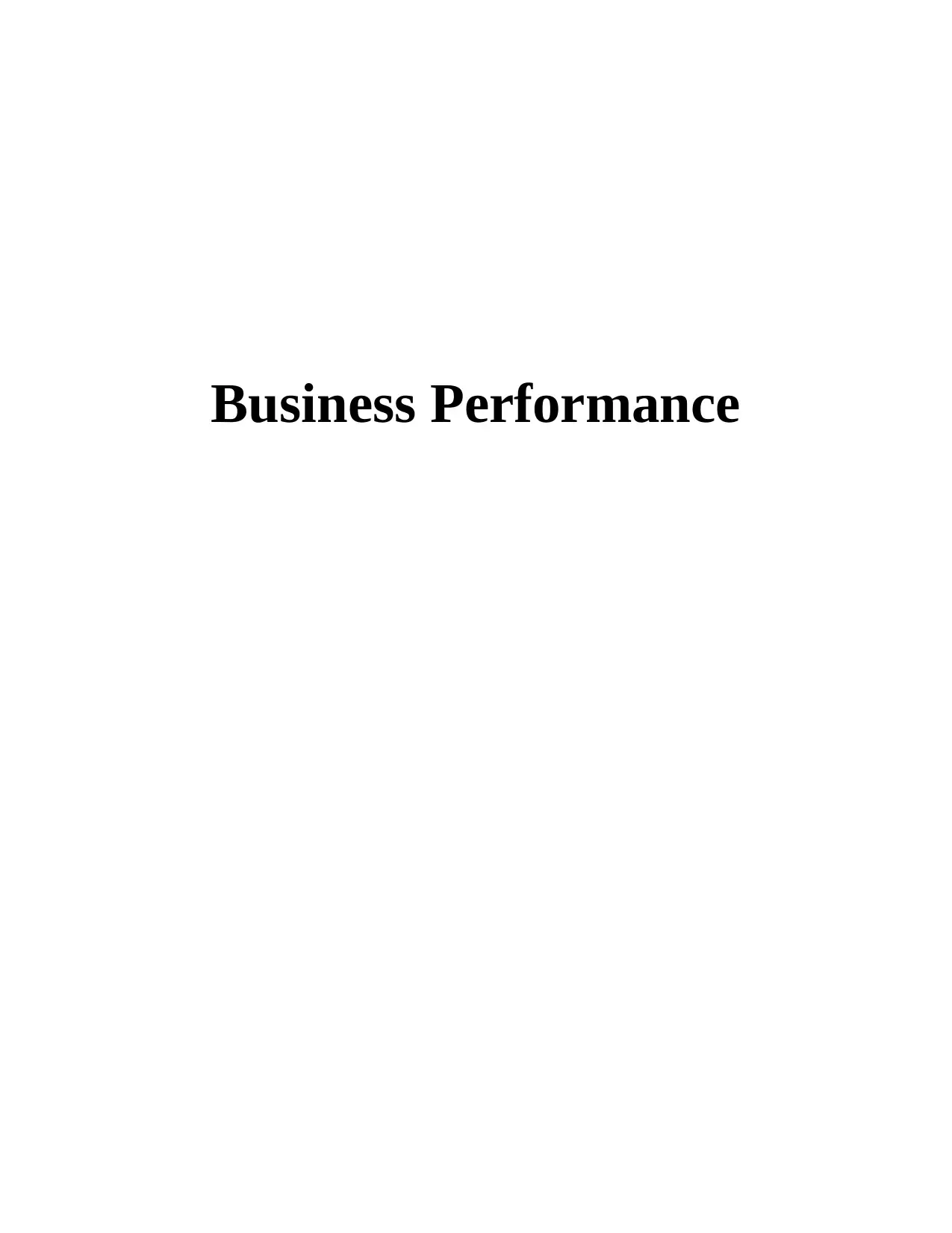
Business Performance
Paraphrase This Document
Need a fresh take? Get an instant paraphrase of this document with our AI Paraphraser
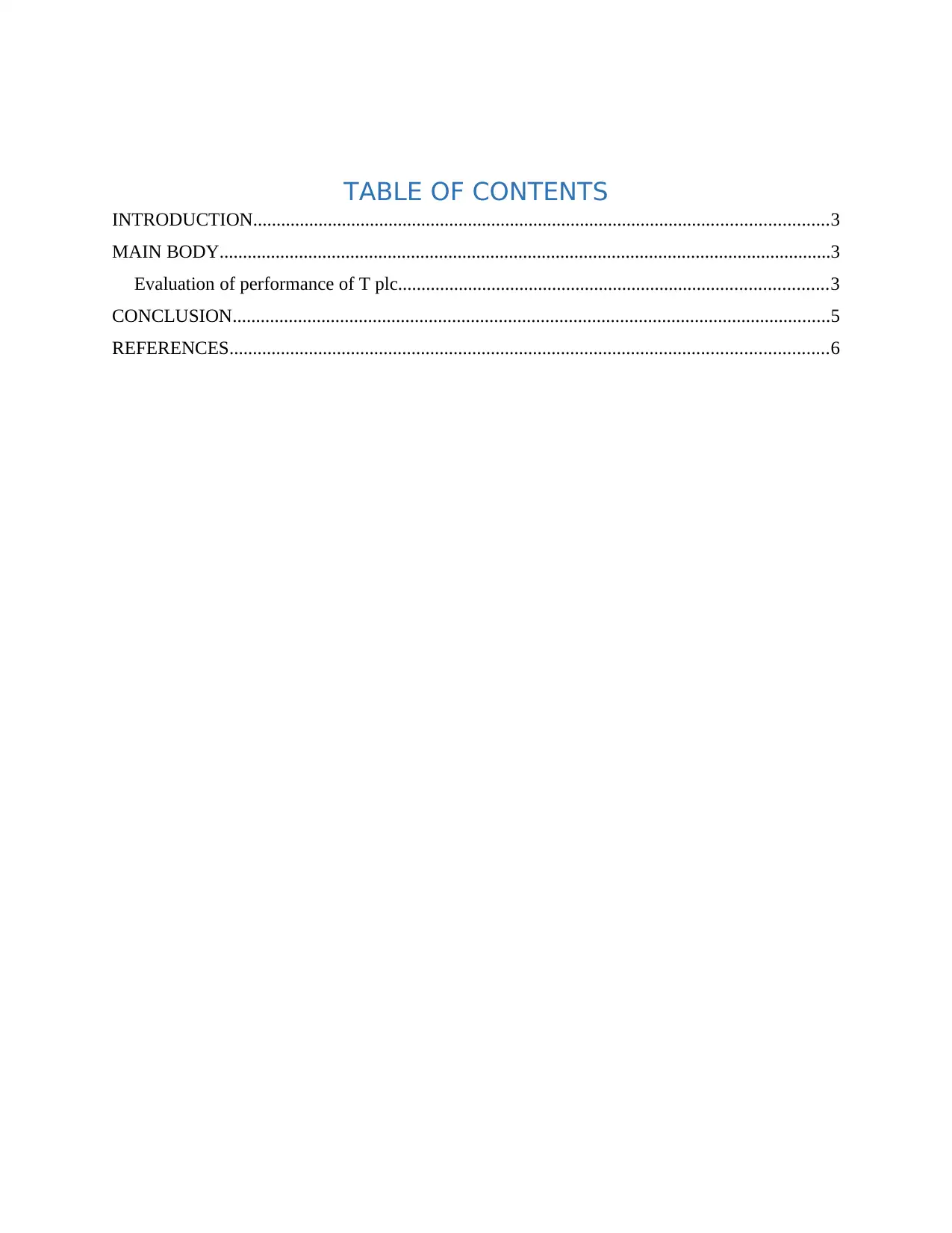
TABLE OF CONTENTS
INTRODUCTION...........................................................................................................................3
MAIN BODY...................................................................................................................................3
Evaluation of performance of T plc............................................................................................3
CONCLUSION................................................................................................................................5
REFERENCES................................................................................................................................6
INTRODUCTION...........................................................................................................................3
MAIN BODY...................................................................................................................................3
Evaluation of performance of T plc............................................................................................3
CONCLUSION................................................................................................................................5
REFERENCES................................................................................................................................6
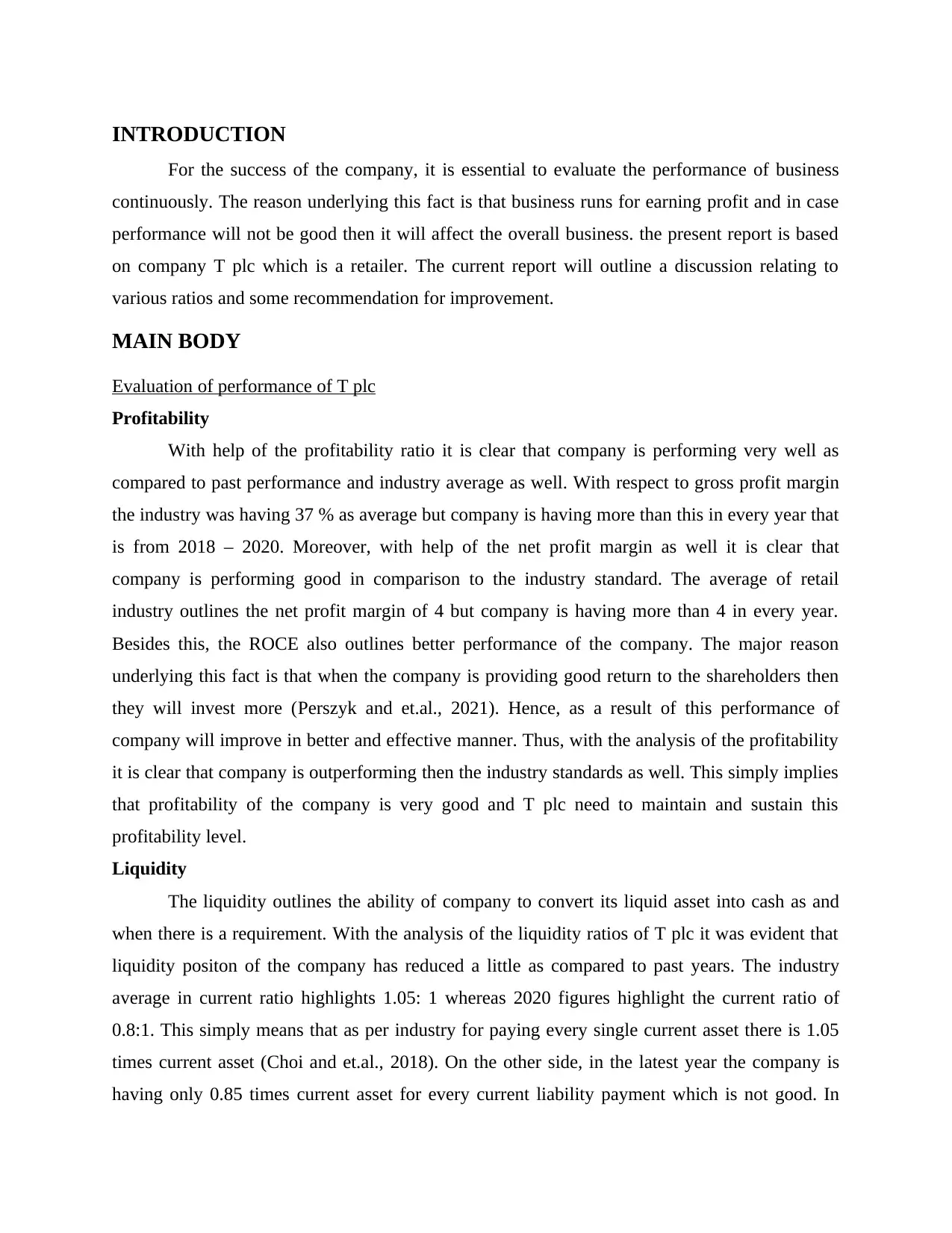
INTRODUCTION
For the success of the company, it is essential to evaluate the performance of business
continuously. The reason underlying this fact is that business runs for earning profit and in case
performance will not be good then it will affect the overall business. the present report is based
on company T plc which is a retailer. The current report will outline a discussion relating to
various ratios and some recommendation for improvement.
MAIN BODY
Evaluation of performance of T plc
Profitability
With help of the profitability ratio it is clear that company is performing very well as
compared to past performance and industry average as well. With respect to gross profit margin
the industry was having 37 % as average but company is having more than this in every year that
is from 2018 – 2020. Moreover, with help of the net profit margin as well it is clear that
company is performing good in comparison to the industry standard. The average of retail
industry outlines the net profit margin of 4 but company is having more than 4 in every year.
Besides this, the ROCE also outlines better performance of the company. The major reason
underlying this fact is that when the company is providing good return to the shareholders then
they will invest more (Perszyk and et.al., 2021). Hence, as a result of this performance of
company will improve in better and effective manner. Thus, with the analysis of the profitability
it is clear that company is outperforming then the industry standards as well. This simply implies
that profitability of the company is very good and T plc need to maintain and sustain this
profitability level.
Liquidity
The liquidity outlines the ability of company to convert its liquid asset into cash as and
when there is a requirement. With the analysis of the liquidity ratios of T plc it was evident that
liquidity positon of the company has reduced a little as compared to past years. The industry
average in current ratio highlights 1.05: 1 whereas 2020 figures highlight the current ratio of
0.8:1. This simply means that as per industry for paying every single current asset there is 1.05
times current asset (Choi and et.al., 2018). On the other side, in the latest year the company is
having only 0.85 times current asset for every current liability payment which is not good. In
For the success of the company, it is essential to evaluate the performance of business
continuously. The reason underlying this fact is that business runs for earning profit and in case
performance will not be good then it will affect the overall business. the present report is based
on company T plc which is a retailer. The current report will outline a discussion relating to
various ratios and some recommendation for improvement.
MAIN BODY
Evaluation of performance of T plc
Profitability
With help of the profitability ratio it is clear that company is performing very well as
compared to past performance and industry average as well. With respect to gross profit margin
the industry was having 37 % as average but company is having more than this in every year that
is from 2018 – 2020. Moreover, with help of the net profit margin as well it is clear that
company is performing good in comparison to the industry standard. The average of retail
industry outlines the net profit margin of 4 but company is having more than 4 in every year.
Besides this, the ROCE also outlines better performance of the company. The major reason
underlying this fact is that when the company is providing good return to the shareholders then
they will invest more (Perszyk and et.al., 2021). Hence, as a result of this performance of
company will improve in better and effective manner. Thus, with the analysis of the profitability
it is clear that company is outperforming then the industry standards as well. This simply implies
that profitability of the company is very good and T plc need to maintain and sustain this
profitability level.
Liquidity
The liquidity outlines the ability of company to convert its liquid asset into cash as and
when there is a requirement. With the analysis of the liquidity ratios of T plc it was evident that
liquidity positon of the company has reduced a little as compared to past years. The industry
average in current ratio highlights 1.05: 1 whereas 2020 figures highlight the current ratio of
0.8:1. This simply means that as per industry for paying every single current asset there is 1.05
times current asset (Choi and et.al., 2018). On the other side, in the latest year the company is
having only 0.85 times current asset for every current liability payment which is not good. In
⊘ This is a preview!⊘
Do you want full access?
Subscribe today to unlock all pages.

Trusted by 1+ million students worldwide
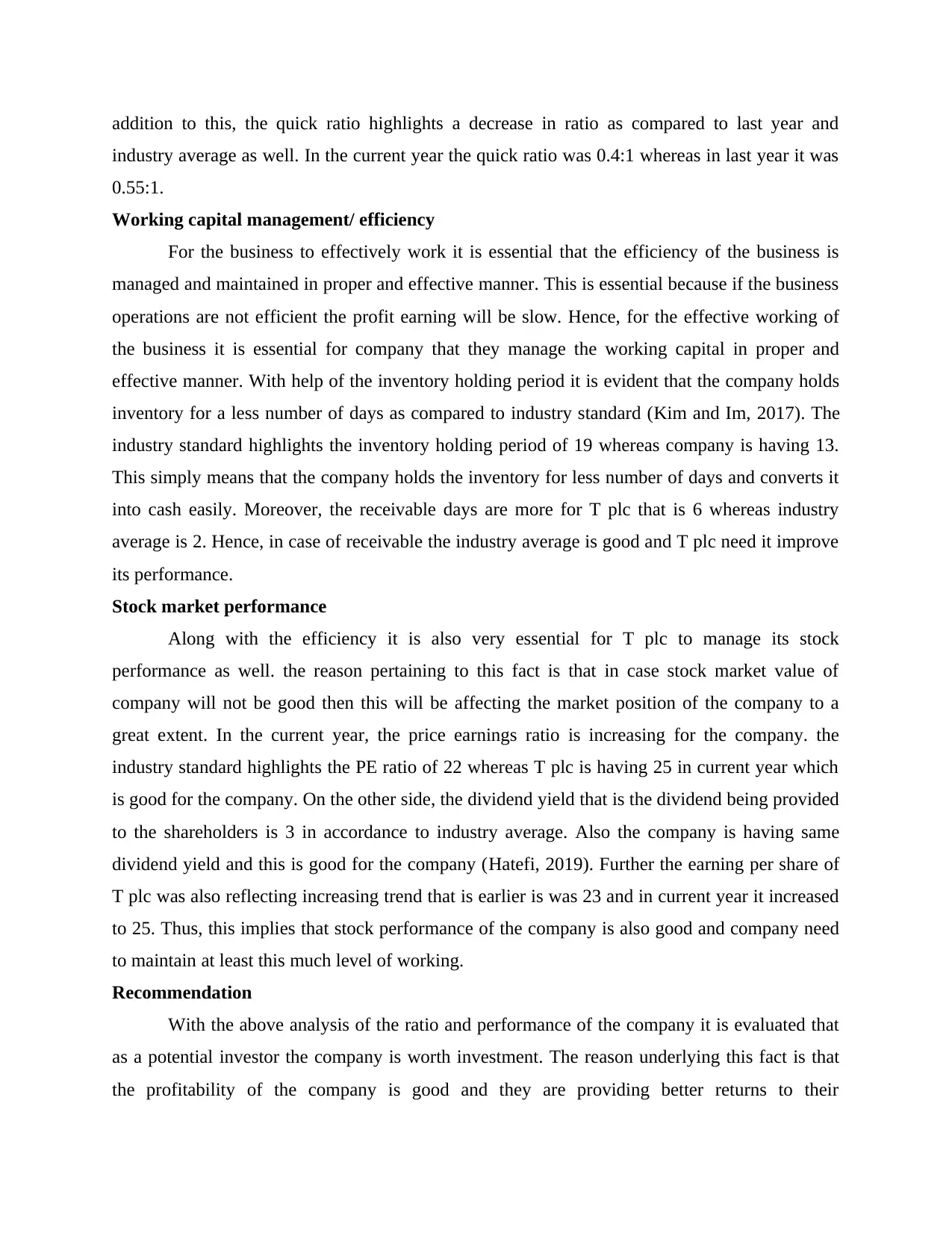
addition to this, the quick ratio highlights a decrease in ratio as compared to last year and
industry average as well. In the current year the quick ratio was 0.4:1 whereas in last year it was
0.55:1.
Working capital management/ efficiency
For the business to effectively work it is essential that the efficiency of the business is
managed and maintained in proper and effective manner. This is essential because if the business
operations are not efficient the profit earning will be slow. Hence, for the effective working of
the business it is essential for company that they manage the working capital in proper and
effective manner. With help of the inventory holding period it is evident that the company holds
inventory for a less number of days as compared to industry standard (Kim and Im, 2017). The
industry standard highlights the inventory holding period of 19 whereas company is having 13.
This simply means that the company holds the inventory for less number of days and converts it
into cash easily. Moreover, the receivable days are more for T plc that is 6 whereas industry
average is 2. Hence, in case of receivable the industry average is good and T plc need it improve
its performance.
Stock market performance
Along with the efficiency it is also very essential for T plc to manage its stock
performance as well. the reason pertaining to this fact is that in case stock market value of
company will not be good then this will be affecting the market position of the company to a
great extent. In the current year, the price earnings ratio is increasing for the company. the
industry standard highlights the PE ratio of 22 whereas T plc is having 25 in current year which
is good for the company. On the other side, the dividend yield that is the dividend being provided
to the shareholders is 3 in accordance to industry average. Also the company is having same
dividend yield and this is good for the company (Hatefi, 2019). Further the earning per share of
T plc was also reflecting increasing trend that is earlier is was 23 and in current year it increased
to 25. Thus, this implies that stock performance of the company is also good and company need
to maintain at least this much level of working.
Recommendation
With the above analysis of the ratio and performance of the company it is evaluated that
as a potential investor the company is worth investment. The reason underlying this fact is that
the profitability of the company is good and they are providing better returns to their
industry average as well. In the current year the quick ratio was 0.4:1 whereas in last year it was
0.55:1.
Working capital management/ efficiency
For the business to effectively work it is essential that the efficiency of the business is
managed and maintained in proper and effective manner. This is essential because if the business
operations are not efficient the profit earning will be slow. Hence, for the effective working of
the business it is essential for company that they manage the working capital in proper and
effective manner. With help of the inventory holding period it is evident that the company holds
inventory for a less number of days as compared to industry standard (Kim and Im, 2017). The
industry standard highlights the inventory holding period of 19 whereas company is having 13.
This simply means that the company holds the inventory for less number of days and converts it
into cash easily. Moreover, the receivable days are more for T plc that is 6 whereas industry
average is 2. Hence, in case of receivable the industry average is good and T plc need it improve
its performance.
Stock market performance
Along with the efficiency it is also very essential for T plc to manage its stock
performance as well. the reason pertaining to this fact is that in case stock market value of
company will not be good then this will be affecting the market position of the company to a
great extent. In the current year, the price earnings ratio is increasing for the company. the
industry standard highlights the PE ratio of 22 whereas T plc is having 25 in current year which
is good for the company. On the other side, the dividend yield that is the dividend being provided
to the shareholders is 3 in accordance to industry average. Also the company is having same
dividend yield and this is good for the company (Hatefi, 2019). Further the earning per share of
T plc was also reflecting increasing trend that is earlier is was 23 and in current year it increased
to 25. Thus, this implies that stock performance of the company is also good and company need
to maintain at least this much level of working.
Recommendation
With the above analysis of the ratio and performance of the company it is evaluated that
as a potential investor the company is worth investment. The reason underlying this fact is that
the profitability of the company is good and they are providing better returns to their
Paraphrase This Document
Need a fresh take? Get an instant paraphrase of this document with our AI Paraphraser
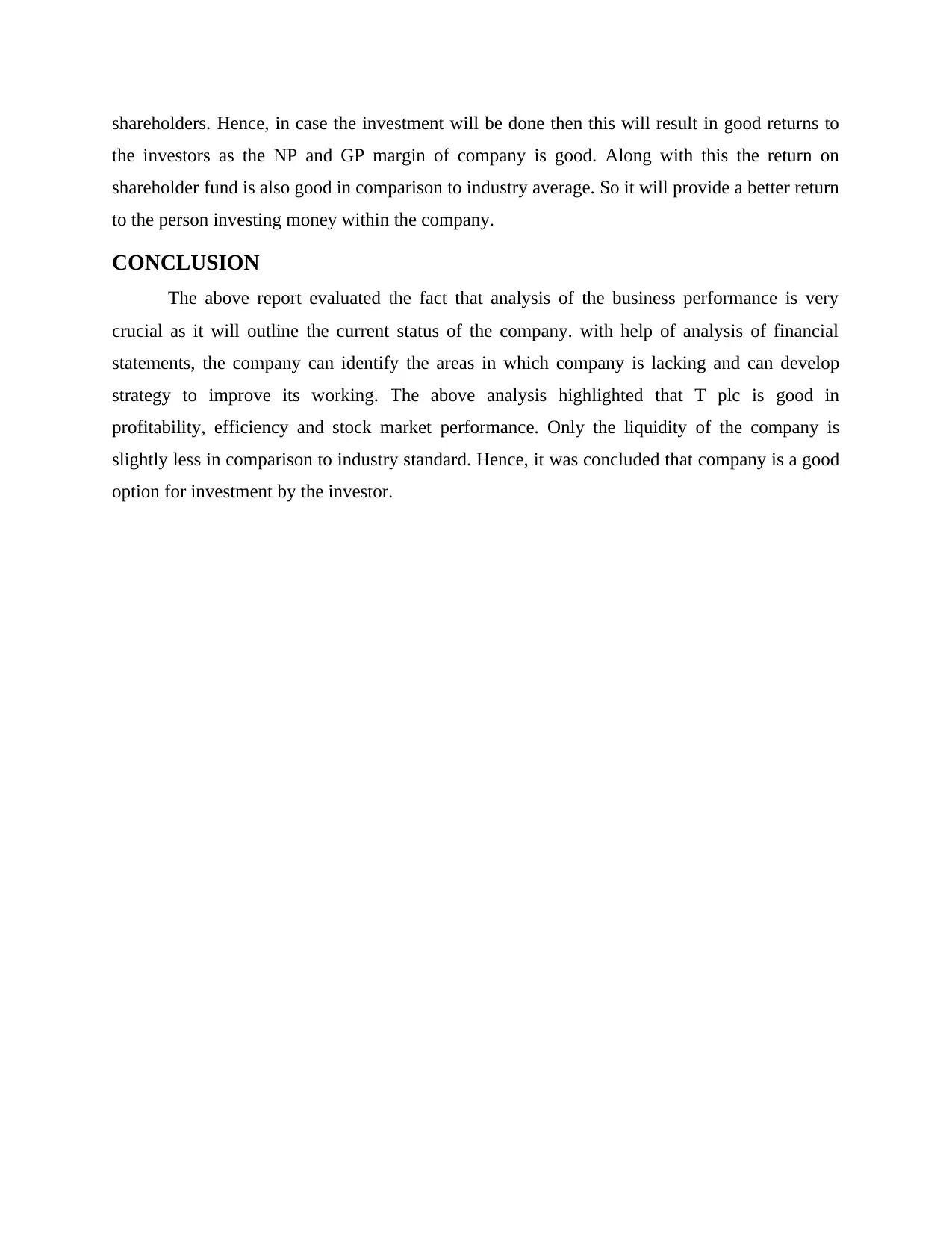
shareholders. Hence, in case the investment will be done then this will result in good returns to
the investors as the NP and GP margin of company is good. Along with this the return on
shareholder fund is also good in comparison to industry average. So it will provide a better return
to the person investing money within the company.
CONCLUSION
The above report evaluated the fact that analysis of the business performance is very
crucial as it will outline the current status of the company. with help of analysis of financial
statements, the company can identify the areas in which company is lacking and can develop
strategy to improve its working. The above analysis highlighted that T plc is good in
profitability, efficiency and stock market performance. Only the liquidity of the company is
slightly less in comparison to industry standard. Hence, it was concluded that company is a good
option for investment by the investor.
the investors as the NP and GP margin of company is good. Along with this the return on
shareholder fund is also good in comparison to industry average. So it will provide a better return
to the person investing money within the company.
CONCLUSION
The above report evaluated the fact that analysis of the business performance is very
crucial as it will outline the current status of the company. with help of analysis of financial
statements, the company can identify the areas in which company is lacking and can develop
strategy to improve its working. The above analysis highlighted that T plc is good in
profitability, efficiency and stock market performance. Only the liquidity of the company is
slightly less in comparison to industry standard. Hence, it was concluded that company is a good
option for investment by the investor.
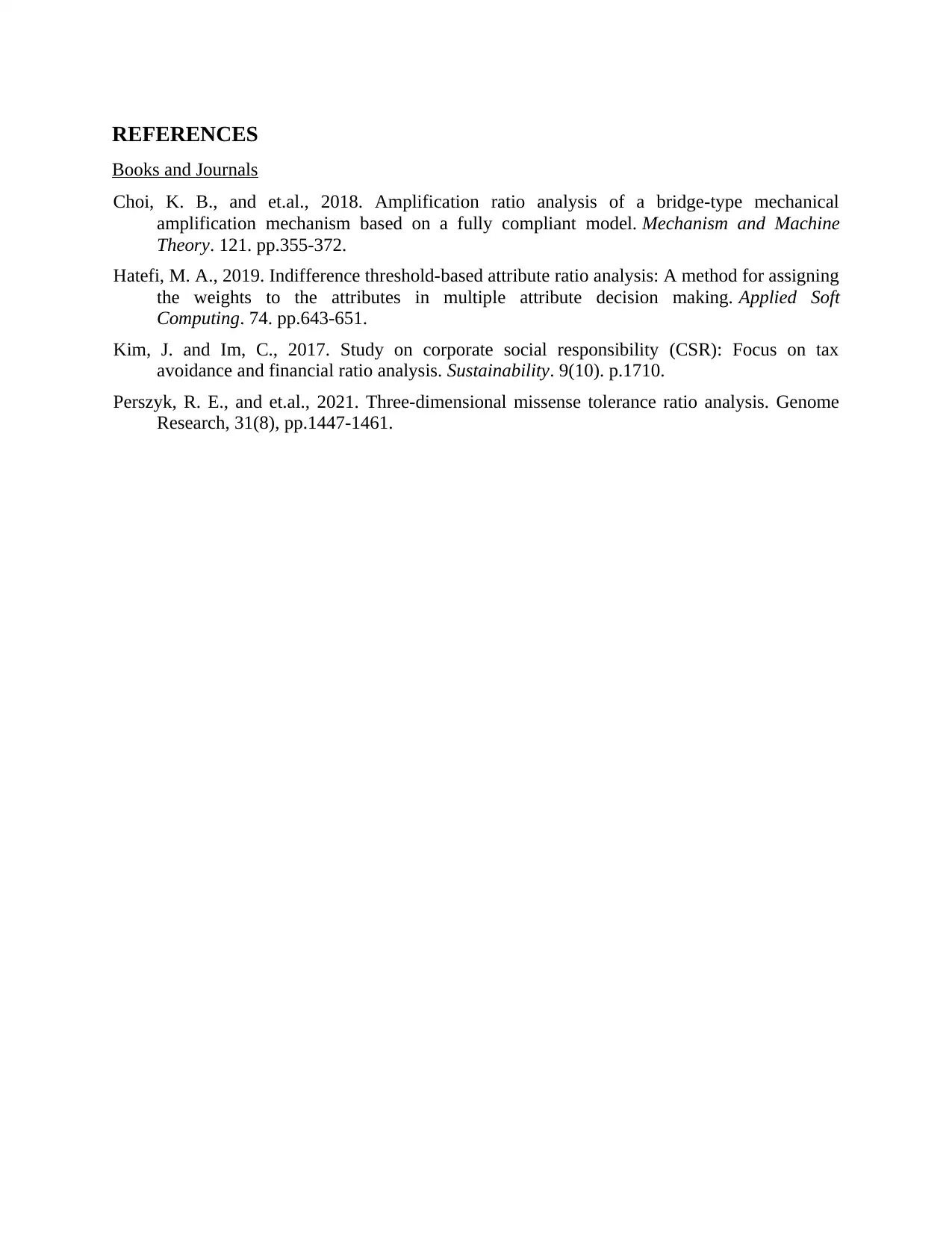
REFERENCES
Books and Journals
Choi, K. B., and et.al., 2018. Amplification ratio analysis of a bridge-type mechanical
amplification mechanism based on a fully compliant model. Mechanism and Machine
Theory. 121. pp.355-372.
Hatefi, M. A., 2019. Indifference threshold-based attribute ratio analysis: A method for assigning
the weights to the attributes in multiple attribute decision making. Applied Soft
Computing. 74. pp.643-651.
Kim, J. and Im, C., 2017. Study on corporate social responsibility (CSR): Focus on tax
avoidance and financial ratio analysis. Sustainability. 9(10). p.1710.
Perszyk, R. E., and et.al., 2021. Three-dimensional missense tolerance ratio analysis. Genome
Research, 31(8), pp.1447-1461.
Books and Journals
Choi, K. B., and et.al., 2018. Amplification ratio analysis of a bridge-type mechanical
amplification mechanism based on a fully compliant model. Mechanism and Machine
Theory. 121. pp.355-372.
Hatefi, M. A., 2019. Indifference threshold-based attribute ratio analysis: A method for assigning
the weights to the attributes in multiple attribute decision making. Applied Soft
Computing. 74. pp.643-651.
Kim, J. and Im, C., 2017. Study on corporate social responsibility (CSR): Focus on tax
avoidance and financial ratio analysis. Sustainability. 9(10). p.1710.
Perszyk, R. E., and et.al., 2021. Three-dimensional missense tolerance ratio analysis. Genome
Research, 31(8), pp.1447-1461.
⊘ This is a preview!⊘
Do you want full access?
Subscribe today to unlock all pages.

Trusted by 1+ million students worldwide
1 out of 6
Related Documents
Your All-in-One AI-Powered Toolkit for Academic Success.
+13062052269
info@desklib.com
Available 24*7 on WhatsApp / Email
![[object Object]](/_next/static/media/star-bottom.7253800d.svg)
Unlock your academic potential
Copyright © 2020–2025 A2Z Services. All Rights Reserved. Developed and managed by ZUCOL.





